Health and Wellness
How CDPAP Enhances Health and Independence

The Consumer Directed Personal Assistance Program (CDPAP) shines as a beacon of empowerment and wellness. This innovative program allows individuals needing home care to take charge of their health management by choosing and directing their caregivers. This approach not only enhances the quality of care but also promotes independence and wellness among its participants. In this blog, we’ll explore how CDPAP is revolutionizing home care and empowering individuals toward better health outcomes.
Personalized Care for Better Health Outcomes
CDPAP stands out by offering a personalized healthcare solution that traditional home care models cannot match. Participants have the liberty to select caregivers who understand their unique needs, preferences, and cultural nuances. This level of personalization ensures that care is not just a service received but a collaborative partnership aimed at achieving optimal health outcomes. By being actively involved in their care decisions, participants are more likely to engage in their health management, leading to improved wellness and independence.
Enhancing Independence Through Self-Direction
Independence is a cornerstone of wellness. CDPAP empowers participants by giving them the authority to direct their care, including the ability to hire, train, and manage their caregivers. This self-direction fosters a sense of autonomy and dignity, crucial elements for anyone receiving care. It enables participants to structure their care around their lifestyle and needs, rather than adjusting their lives to fit a pre-determined care schedule. This flexibility is instrumental in maintaining an active and independent lifestyle.
Building Meaningful Caregiver Relationships
The ability to choose caregivers often leads to the selection of family members, friends, or individuals within the participant’s community, fostering a deeper, more meaningful connection. These caregivers have a vested interest in the participant’s well-being, often leading to more compassionate, attentive, and personalized care. Such relationships enhance the mental and emotional well-being of participants, which is vital for overall health and wellness.
Encouraging Active Participation in Wellness
CDPAP encourages participants to take an active role in their wellness journey. This active participation extends beyond directing care; it encompasses making informed health decisions, engaging in physical activities tailored to their abilities, and adopting healthier lifestyle choices. The program supports a holistic approach to wellness, recognizing that health is not merely the absence of illness but a state of complete physical, mental, and social well-being.
Overcoming Barriers to Care
Accessibility to quality care is a significant barrier for many individuals. CDPAP addresses this challenge by making home care more accessible and tailored to the participant’s needs. By removing bureaucratic hurdles and simplifying the process of receiving care, CDPAP ensures that more people can access the support they need to live healthily and independently.
CDPAP represents a paradigm shift in home healthcare, placing the power of choice and independence in the hands of those who need it the most. By fostering personalized care, enhancing independence, building meaningful relationships, encouraging active wellness participation, and overcoming barriers to care, CDPAP is not just a program; it’s a pathway to empowered wellness. As we continue to advocate for personalized and patient-centered care models, CDPAP stands as a testament to the profound impact of empowering individuals in their healthcare journey.
A Guide to Mental Wellness for Personal Assistants and Their Recipients

In the realm of caregiving, the mental wellness of both personal assistants and their recipients stands as a pivotal aspect of health that often goes underappreciated. The unique bond shared between caregivers and those they assist is not just built on the physical aspects of care but also on the profound impact they have on each other’s mental and emotional well-being.
Understanding the Emotional Landscape of Caregiving
Caregiving, by its very nature, is an emotionally taxing role that demands a great deal of compassion, patience, and resilience. Personal assistants often find themselves in challenging situations that can lead to stress, burnout, and emotional exhaustion. Similarly, individuals receiving care may experience feelings of dependency, loss of privacy, and frustration, which can affect their mental health. Recognizing these emotional complexities is the first step toward fostering a supportive care environment.
Strategies for Personal Assistants
- Practice Self-Care: Personal assistants should prioritize their well-being by engaging in regular self-care routines. This can include mindfulness practices, physical activity, adequate rest, and pursuing hobbies or interests that bring joy.
- Establish Boundaries: Setting clear professional and personal boundaries helps prevent burnout. Knowing when to step back and take time for oneself is crucial in maintaining emotional resilience.
- Seek Support: Joining support groups or seeking professional counseling can provide a safe space to express concerns, share experiences, and receive emotional support from others in similar situations.
Strategies for Recipients
- Open Communication: Recipients should feel empowered to express their needs, concerns, and preferences regarding their care. Open and honest communication fosters a trusting relationship and helps address any emotional distress.
- Engage in Social Activities: Maintaining social connections and engaging in activities that promote a sense of community and belonging can significantly impact mental wellness.
- Adopt a Wellness Routine: Incorporating activities that promote mental health, such as reading, meditation, or gentle exercise, can enhance emotional well-being and provide a sense of control over one’s life.
Building a Supportive Caregiving Relationship
The foundation of a positive caregiving relationship lies in mutual respect, understanding, and empathy. Here are ways to cultivate such an environment:
- Promote Teamwork: Viewing the caregiver-recipient relationship as a team effort encourages collaboration and shared responsibility for mental wellness.
- Celebrate Small Wins: Recognizing and celebrating achievements, no matter how small, can boost morale and reinforce a positive outlook.
- Encourage Independence: Whenever possible, supporting the recipient’s independence can lead to improved self-esteem and mental health.
The mental wellness of personal assistants and their recipients is integral to the success and sustainability of the caregiving relationship. By implementing strategies that prioritize emotional health, establishing clear communication, and fostering a supportive partnership, both caregivers and those receiving care can navigate the challenges of caregiving with resilience and compassion.
Healthy Eating Tips for CDPAP Consumers and Caregivers

The unique structure of CDPAP offers an opportunity for consumers and caregivers to collaborate on implementing healthy eating habits as part of a comprehensive care plan. This blog provides essential healthy eating tips designed to empower CDPAP consumers and caregivers, fostering a nurturing environment conducive to optimal health.
Understanding the Importance of Nutrition in Care
Nutrition is the cornerstone of health. For CDPAP consumers, particularly those with chronic conditions or mobility issues, a balanced diet can significantly impact their overall health, mood, and energy levels. Similarly, caregivers need proper nutrition to maintain their energy, health, and ability to provide effective care. A focus on nutritious eating can help manage health conditions, reduce the risk of new complications, and promote a better quality of life.
Healthy Eating Tips for CDPAP Consumers and Caregivers
Plan Balanced Meals Together: Planning meals can be a collaborative activity that encourages healthy eating habits. Focus on a diet rich in fruits, vegetables, whole grains, lean proteins, and healthy fats. Consider any dietary restrictions or preferences of the consumer and incorporate them into the meal plan.
Stay Hydrated: Adequate hydration is essential for overall health. Encourage each other to drink plenty of water throughout the day, and limit high-sugar or caffeinated beverages, which can lead to dehydration.
Mindful Snacking: Choose snacks that are nutritious and satisfying. Fresh fruits, and vegetables with hummus, nuts, and low-fat yogurt are great options. Snacking wisely can help maintain energy levels and prevent overeating at meal times.
Cook Meals at Home: Home-cooked meals are generally healthier and more nutritious than processed foods or takeout. Cooking at home also allows for better control over ingredients and portion sizes. Sharing the cooking responsibility or cooking together can make this task more enjoyable and less burdensome.
Read Nutrition Labels: Being informed about what’s in the food you eat can help make healthier choices. Pay attention to serving sizes, calories, and nutrient content, especially for packaged foods.
Manage Portion Sizes: Eating the right portion sizes can help control calorie intake and prevent weight gain. Use smaller plates or bowls to help manage portions, and listen to your body’s hunger and fullness cues.
Prioritize Dietary Needs: If the consumer has specific dietary needs due to health conditions, make sure to incorporate these into the meal planning. Consulting with a nutritionist or dietitian can provide tailored advice to meet these needs effectively.
Stay Active Together: While not directly related to nutrition, physical activity is an important part of a healthy lifestyle. Find ways to incorporate physical activities that are enjoyable and suitable for both the consumer’s and caregiver’s abilities.
Creating a Supportive Nutrition Environment
Fostering an environment that supports healthy eating involves regular communication, encouragement, and mutual respect for preferences and needs. Celebrate nutritional successes together, whether it’s sticking to a healthy eating plan, trying new nutritious recipes, or achieving personal health goals.
In the CDPAP setting, where consumers and caregivers share a unique and personal connection, integrating healthy eating practices into daily care routines can significantly enhance the well-being of both parties. By adopting these healthy eating tips, CDPAP consumers and caregivers can work together towards a healthier, more vibrant life. Remember, nutrition matters, and by making informed, mindful choices about food, everyone involved in the caregiving process can reap the benefits of improved health and wellness.
Physical Activity and Mobility: Staying Active with CDPAP Assistance

CDPAP empowers consumers to take control of their care by allowing them to hire, train, and manage their caregivers. This unique model not only enhances the quality of care but also opens doors to tailored physical activity and mobility programs that cater specifically to the consumer’s needs. Here, we explore how staying active with CDPAP assistance can significantly improve the quality of life for individuals requiring care.
The Importance of Physical Activity for CDPAP Consumers
Regular physical activity is a cornerstone of good health, impacting everything from cardiovascular fitness to mental well-being. For CDPAP consumers, especially those with limited mobility or chronic conditions, engaging in physical activity can seem daunting. However, with the right support from a personal assistant, even small movements can lead to big improvements in health, mood, and overall mobility.
Tailored Exercise Programs with CDPAP
One of the most significant benefits of the CDPAP program is the ability to customize care, including physical activity routines. Personal assistants, who are often family members or close friends, can work with consumers to develop and implement exercise plans that are not only safe but also enjoyable and directly aligned with the consumer’s health goals and abilities.
Tips for Staying Active with CDPAP Assistance:
Start with a Plan: Consult with healthcare professionals to create a personalized exercise plan. Consider the consumer’s current health status, mobility levels, and interests to ensure the plan is both effective and engaging.
Incorporate a Variety of Activities: Mix different types of exercises to keep the routine interesting. This can include strength training, balance exercises, stretching, and low-impact aerobic activities. Variety can help engage different muscle groups and prevent boredom.
Set Realistic Goals: Establish achievable goals to keep motivation high. Celebrating small milestones can provide a sense of accomplishment and encourage continued effort.
Use Adaptive Equipment: There’s a wide range of adaptive equipment available to assist with exercises, from resistance bands to seated exercise machines. These tools can help make physical activity accessible and enjoyable, regardless of mobility limitations.
Stay Consistent but Flexible: Consistency is key to seeing benefits from any exercise program. However, it’s also important to remain flexible and adjust the plan as needed based on the consumer’s energy levels and health status.
Monitor and Adjust: Regularly assess the exercise routine’s effectiveness and make adjustments as needed. This might involve increasing the intensity of workouts, introducing new activities, or scaling back if necessary.
The Role of Personal Assistants in Promoting Physical Activity
Personal assistants play a critical role in facilitating physical activity for CDPAP consumers. Their support can range from providing physical assistance during exercises to offering encouragement and motivation. By actively participating in the exercise routine, personal assistants can help create a supportive environment that emphasizes the importance of staying active for both physical and mental health.
For CDPAP consumers, maintaining physical activity is essential for enhancing mobility, independence, and overall well-being. With the support of personal assistants, individuals can enjoy personalized exercise routines that cater to their specific needs and goals. Staying active with CDPAP assistance is not just about improving physical health; it’s also about empowering consumers to lead more active, fulfilling lives. Remember, every movement counts, and with the right support, achieving better health and mobility is within reach.
Stress Management Strategies for Caregivers and Their Loved Ones

Caring for a loved one can be a deeply rewarding experience, but it also comes with its fair share of challenges, particularly stress. Caregivers often find themselves in the dual role of provider and confidant, balancing their own needs with those of the person they’re caring for. This article explores practical stress management strategies designed to support both caregivers and their loved ones, fostering a healthier, more supportive care environment.
Understanding the Stress of Caregiving
Caregiving stress can stem from various sources, including emotional strain, financial pressures, and the physical demands of providing care. Recognizing the signs of stress is the first step toward managing it. Symptoms can include feelings of overwhelm, irritability, fatigue, and changes in appetite or sleep patterns. Acknowledging these feelings and understanding their sources is crucial in developing effective stress management strategies.
Strategies for Caregivers:
Set Realistic Goals: Accept that you can’t do everything on your own. Set achievable goals and prioritize tasks to make caregiving more manageable.
Seek Support: Don’t hesitate to reach out for help. Joining a caregiver support group can provide valuable advice and emotional support from those in similar situations.
Take Care of Your Health: Neglecting your health will only exacerbate stress. Ensure you’re eating well, getting enough sleep, and exercising regularly.
Practice Mindfulness: Techniques such as meditation, deep breathing exercises, and yoga can help reduce stress and improve your mental health.
Schedule Regular Breaks: Make time for yourself to enjoy activities that relax and rejuvenate you. This isn’t selfish—it’s necessary for maintaining your well-being.
Strategies for Loved Ones:
Open Communication: Encourage open dialogue about feelings and needs. Understanding each other’s perspectives can reduce stress and improve the caregiving relationship.
Participate in Care Decisions: Involve your loved ones in decisions about their care as much as possible. This can give them a sense of control and reduce feelings of helplessness.
Encourage Independence: Support your loved one’s ability to do things on their own, as appropriate. This fosters a sense of autonomy and dignity.
Find Enjoyable Activities: Engage in activities together that you both enjoy. This can help relieve stress and strengthen your bond.
Use Technology: Various apps and devices can help manage medication schedules, appointments, and communication, reducing stress for both parties.
Caregiving is a journey that requires patience, understanding, and compassion. By employing these stress management strategies, caregivers and their loved ones can navigate the challenges of caregiving with resilience and grace. Remember, taking care of yourself is not an act of selfishness; it’s a necessity. By managing your stress effectively, you’ll be better equipped to provide the care and support your loved one needs.
By adopting these strategies, caregivers can mitigate the stress associated with their roles, ensuring a healthier and more positive experience for both themselves and their loved ones. Remember, it’s okay to ask for help, and taking time for self-care is not a luxury—it’s essential. Through mutual support and understanding, caregivers and their loved ones can navigate the complexities of caregiving together, fostering a nurturing and stress-free environment.
Understanding and Managing Chronic Conditions with CDPAP Support
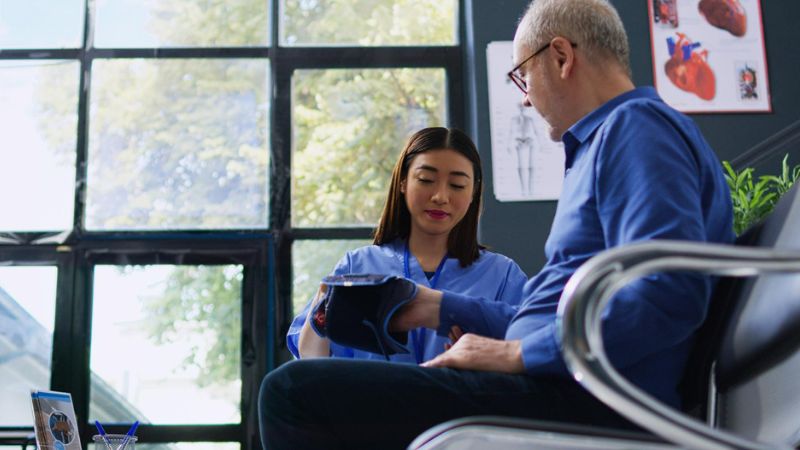
Chronic conditions present a significant challenge not only to the individuals directly affected but also to their families and caregivers. With the rise of long-term illnesses such as diabetes, heart disease, and Alzheimer’s, the need for personalized, continuous care is more crucial than ever. The Consumer Directed Personal Assistance Program (CDPAP) offers a unique solution to this issue, empowering patients by giving them control over their care. This article delves into the nature of chronic conditions, the role of CDPAP in managing these conditions, and how patients and families can leverage this program to improve their quality of life.
The Burden of Chronic Conditions
Chronic conditions are long-lasting health issues that typically cannot be cured but can be managed through medication, lifestyle changes, and therapy. The management of such conditions not only requires medical intervention but also a considerable amount of daily care and support. This continuous need can place a significant burden on both the patients and their families, often leading to emotional, physical, and financial stress.
Advantages of CDPAP in Managing Chronic Conditions:
Personalized Care
One of the most significant advantages of CDPAP is the ability to personalize care according to the specific needs and preferences of the individual. This personalization is particularly beneficial for managing chronic conditions, where daily needs can vary greatly from one person to another.
Emotional Comfort and Stability
Receiving care from a known and trusted individual can provide emotional comfort and stability to patients. This aspect is crucial for individuals with chronic conditions, as mental and emotional health is a significant component of overall well-being.
Flexibility and Control
CDPAP gives patients and their families more control over the caregiving process, including setting schedules and defining the scope of care. This level of control can lead to more effective management of chronic conditions, as the care plan can be quickly adjusted to meet changing needs.
Economic Efficiency
For many families, CDPAP also presents an economically efficient option. By allowing patients to direct their care, the program can reduce the need for more expensive institutional care options. Furthermore, compensating family members or friends for the care they are already providing can help alleviate the financial burdens associated with caregiving.
How to Leverage CDPAP for Chronic Condition Management:
Understand Eligibility: Begin by researching whether CDPAP is available in your state and understanding the eligibility criteria, which typically include being a Medicaid recipient.
Assess Needs: Work with healthcare professionals to assess the patient’s needs and determine how CDPAP can best support their management plan for the chronic condition.
Choose Caregivers Wisely: Select caregivers who are not only trustworthy and reliable but also willing to learn and adapt to the specific needs of the patient.
Develop a Care Plan: Create a detailed care plan that includes daily routines, medication schedules, physical therapy exercises, and any other necessary activities. Ensure the caregiver is fully trained on this plan.
Maintain Open Communication: Keep lines of communication open between the patient, caregivers, and healthcare providers to ensure the care plan remains effective and can be adjusted as needed.
Managing chronic conditions requires a comprehensive approach that addresses the medical, emotional, and daily needs of the individual. CDPAP offers a unique and empowering solution by allowing patients to take control of their care, ensuring they receive the personalized support they need in the comfort of their own homes. By leveraging the benefits of CDPAP, patients and their families can navigate the challenges of chronic conditions more effectively, leading to improved quality of life and well-being.
Preventative Care Practices for a Healthier Tomorrow with CDPAP

In the quest for a healthier tomorrow, preventative care stands out as a beacon of proactive health management. The essence of preventative care lies in taking measures to avert diseases and health issues before they occur, rather than treating them after they manifest. With the increasing prevalence of chronic diseases and the rising costs of healthcare, the importance of preventative care has never been more critical.
The Consumer Directed Personal Assistance Program (CDPAP) plays a pivotal role in this context, offering a unique approach to integrating preventative care practices into the daily lives of those with chronic conditions or the elderly. This article explores how CDPAP can be leveraged to foster a culture of preventative care, thereby paving the way for a healthier future.
Understanding Preventative Care
Preventative care encompasses a broad range of activities, from regular health screenings and immunizations to lifestyle adjustments aimed at reducing the risk of chronic diseases. It’s a holistic approach that not only focuses on the physical aspects of health but also considers mental and emotional well-being. By identifying risk factors and potential health issues early, individuals can take steps to avoid more severe complications down the line.
The Role of CDPAP in Preventative Care
The Consumer Directed Personal Assistance Program (CDPAP) empowers individuals requiring care to take charge of their health by selecting their caregivers, who can be family members, friends, or other non-professionals. This model offers a unique opportunity to incorporate preventative care practices into everyday routines, customized to the individual’s specific needs and circumstances.
Here’s how CDPAP facilitates a preventative care approach:
Personalized Care Plans
With CDPAP, care recipients have the autonomy to direct their care, including the implementation of personalized care plans that emphasize preventative measures. These plans can be tailored to address specific risk factors, such as managing blood sugar levels to prevent diabetes complications or engaging in regular physical activity to reduce the risk of heart disease.
Education and Awareness
Caregivers under CDPAP can play a significant role in educating care recipients about the importance of preventative care and how to implement it in their daily lives. This education might include nutritional guidance, the importance of staying active, and how to monitor for signs of emerging health issues.
Enhanced Communication with Healthcare Providers
CDPAP caregivers are often in a unique position to facilitate communication between care recipients and their healthcare providers. They can help ensure that the individual attends regular check-ups and screenings, follows through with immunizations, and maintains an open line of communication about any health concerns that may arise.
Support for Mental and Emotional Health
Preventative care also encompasses mental and emotional well-being. Caregivers can support care recipients by providing companionship, encouraging social interaction, and helping to manage stress, all of which are vital for preventing mental health conditions such as depression and anxiety.
Leveraging CDPAP for Preventative Care
To maximize the benefits of CDPAP in promoting preventative care, consider the following strategies:
Conduct Regular Assessments: Regularly evaluate the care recipient’s health status and adjust the care plan as needed to address new or changing risk factors.
Promote a Healthy Lifestyle: Encourage a balanced diet, regular exercise, and adequate sleep as fundamental components of the care plan.
Ensure Compliance with Medical Recommendations: Support the care recipient in adhering to medical advice, including medication management and attending all scheduled health screenings.
Foster a Supportive Environment: Create an environment that supports the emotional and mental health of the care recipient, recognizing that a positive outlook can significantly impact physical health.
Preventative care is a crucial element in the pursuit of a healthier tomorrow. Through CDPAP, individuals have the opportunity to integrate personalized preventative care practices into their daily lives, with the support of caregivers who understand their unique needs and preferences. By embracing a proactive approach to health, and leveraging the flexibility and personalized care that CDPAP offers, we can take significant strides towards preventing chronic conditions and promoting a culture of health and well-being for all.
Simple Exercise Plans for Seniors Under CDPAP Care
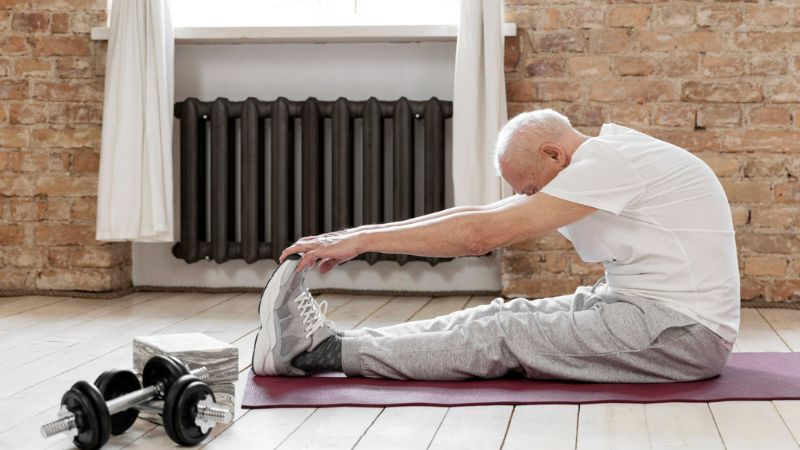
Under the CDPAP, many seniors have the unique opportunity to take charge of their health care, including the physical activities they engage in. This blog will walk you through simple exercise plans specifically designed for seniors receiving CDPAP care, blending medical insights with practical steps to enhance your vitality. So, let’s stretch those muscles and possibly, just maybe, crack a smile as we dive into the world of active aging.
The Importance of Exercise for Seniors
It’s no secret that with age, maintaining an active lifestyle becomes not just beneficial, but essential. Exercise for seniors can help manage weight, strengthen the heart, and reduce the risk of chronic diseases such as diabetes, heart disease, and arthritis. Moreover, physical activity helps enhance mobility and balance, reducing the risk of falls—a common concern among the elderly.
Tailoring Exercise to Senior Needs Under CDPAP
The beauty of CDPAP is that the exercise regimen can be customized with the help of a caregiver who understands the senior’s health baseline and goals. Here’s how you can tailor a workout plan:
Consult with Healthcare Providers
Always start with a consultation. Your healthcare provider can offer advice on exercise limitations and safe workout intensities.
Incorporate Balance and Flexibility Workouts
Exercises like Tai Chi, yoga, and simple stretching can improve both balance and flexibility, which are crucial for preventing falls.
Strength Training Adaptations
Lightweight or resistance band exercises can be performed even while seated, making them perfect for those with mobility limitations.
Endurance Activities
Activities such as walking or aqua aerobics can be paced appropriately for the senior’s endurance levels, ideally under the watchful eye of their CDPAP caregiver.
Sample Exercise Plan for Seniors Under CDPAP Care
Let’s lace up our shoes and look at a sample weekly exercise plan:
- Monday: 30 minutes of water aerobics, gentle on the joints.
- Wednesday: 15 minutes of seated resistance band routines, focusing on upper body strength.
- Friday: 30 minutes of walking, paced as per the senior’s comfort.
- Sunday: 20 minutes of Tai Chi, perfect for balance and tranquility.
Safety Tips During Exercises
Safety can’t be stressed enough when it comes to seniors exercising. Here are some tips to ensure a safe workout environment:
- Monitor Heart Rate: Keep tabs on the senior’s heart rate and breathing.
- Hydrate: Always have water on hand to avoid dehydration.
- Use Appropriate Gear: Nonslip shoes and comfortable clothing can prevent accidents.
- Supervise: The caregiver should always be present to assist and monitor for signs of distress.
The Role of Diet in Conjunction with Exercise
No exercise plan is complete without considering nutrition—fuel for the elderly engines! A balanced diet rich in calcium, vitamins, and proteins, along with hydration, can significantly complement physical activity, enhancing overall health and recovery.
The Beginner's Guide to Managing Medication in CDPAP Care

Picture this: you’re stepping into the role of a caregiver in the CDPAP framework, a scenario where you’re not just a caregiver but also an organizer, a mentor, and a key player in medication management. The Consumer Directed Personal Assistance Program (CDPAP) empowers individuals to manage their care by hiring caregivers of their choice, which often includes family members. But with great power comes great responsibility—especially when it comes to the critical task of managing medications.
Medication management in the context of CDPAP is not merely about ensuring medicine is taken on time. It encompasses understanding the medications, coordinating with healthcare providers, and making informed decisions to support the health and well-being of the care recipient. For beginners, this can seem overwhelming, but don’t worry! This guide is packed with easy-to-follow tips and essential practices to help you become proficient in managing medication effectively within the CDPAP setting.
Why is Medication Management Important?
Proper medication management can dramatically influence the quality of life and health outcomes of the patient. It involves not only the timely administration of drugs but also monitoring their effectiveness and side effects, understanding drug interactions, and maintaining clear and open communication with healthcare providers.
Getting Started with Medication Management
Document Everything
Start by creating a comprehensive list of all medications, including prescription drugs, over-the-counter solutions, and supplements. This list should include:
- The name of the medication.
- The purpose of the medication.
- Dosage instructions.
- Timing and frequency of administration.
- Possible side effects and interactions.
Use Tools and Technology
Leverage apps and devices designed for medication management. Many apps can help you track doses, set reminders, and even provide information on drug interactions.
Establish a Routine
Set a daily medication routine that fits seamlessly into the patient’s schedule. Consistency is key in medication management to maintain therapeutic levels of medication in the body.
Secure Medications
Ensure that all medications are stored safely and are out of reach of unauthorized individuals. Proper storage also involves considering the temperature and humidity guidelines specific to each medication.
Regular Reviews with Healthcare Providers
Schedule regular medication reviews with the patient’s healthcare provider. This is crucial for adjusting dosages, adding new medications, or discontinuing ones that are no longer needed.
Overcoming Common Challenges
Dealing with Side Effects
Educate yourself about the potential side effects of each medication. Knowing what to expect and when to seek medical advice are integral parts of effective medication management.
Handling Refills
Keep a calendar for refills to avoid running out of medications. Many pharmacies also offer automatic refill programs to simplify this process.
Ensuring Compliance
Understand the reasons behind medication noncompliance and work to address them. This may involve adjusting schedules, altering dosages, or even changing medications, in consultation with a healthcare professional.
Stepping into the role of a medication manager in a CDPAP arrangement can be daunting, but with the right tools and strategies, it is manageable. By staying organized, using the available technology, and maintaining open lines of communication with medical professionals, you can ensure that medication management is a success.
By tackling this responsibility, you not only support the health and wellness of the care recipient but also empower them to live a more independent, fulfilling life at home. Now, you’re not just a caregiver—you’re a pivotal part of a caring and professional support system.
Creating a Balanced Daily Routine with CDPAP

Imagine navigating your day with the confidence that every task is perfectly aligned with your health needs and those of your loved ones. For caregivers and patients within the Consumer Directed Personal Assistance Program (CDPAP), creating a balanced daily routine isn’t just a goal—it’s essential for maintaining a healthy and fulfilling life.
This program, which allows individuals to choose and direct their caregivers, demands a structured yet flexible routine to maximize the benefits for both the caregiver and the recipient. In this guide, we’ll explore how to establish a daily routine that harmonizes care responsibilities with everyday life, ensuring that everyone’s needs are met with grace and efficiency.
The Importance of a Balanced Routine in CDPAP
The Essence of CDPAP
Under CDPAP, patients (consumers) have the unique opportunity to recruit, hire, and direct their caregivers—which often include family members. This model not only emphasizes personalized care but also places the responsibility of daily health management in the hands of those who best understand the patient’s needs.
Why Balance is Crucial?
A well-balanced routine helps in reducing caregiver burnout, enhancing patient satisfaction, and promoting overall mental and physical health. For caregivers, a predictable routine can provide a sense of control and reduce stress, while patients benefit from the consistent and tailored care that a structured day provides.
Crafting Your Balanced Daily Routine
Start with a Good Morning Ritual
Kick off the day with a morning routine that energizes and sets a positive tone. This could involve a simple breakfast, a short exercise session, or a few moments of meditation. Align these activities with the patient’s health directives to ensure they start their day right.
Schedule Regular Medical Care
Integrate necessary medical care into the daily routine. This includes administering medication, performing physical therapy, and any other prescribed health measures. Use alarms or apps to keep track of time and ensure no treatment is missed.
Incorporate Physical Activity
Depending on the patient’s condition, include light to moderate physical activity. Activities like walking, stretching, or specific rehabilitative exercises can be immensely beneficial for both physical and mental health.
Set Aside Time for Meals and Nutrition
Nutrition is pivotal in healthcare. Plan and prepare meals that cater to the dietary needs of the patient. Eating at regular times not only helps in medication efficacy but also in maintaining energy levels throughout the day.
Include Breaks and Leisure Time
Balance care tasks with breaks and leisure activities to keep spirits high. Engage in hobbies, watch a favorite show, or simply spend time in nature. This not only rejuvenates the caregiver but also enhances the patient’s quality of life.
End the Day Peacefully
Create a calming nighttime routine to help both the caregiver and the patient unwind. This may include a light snack, a warm bath, or some quiet time together. Regular sleep schedules promote better health and well-being.
Tools and Tips to Maintain the Routine
Use of Technology
Leverage technology with apps that can schedule and remind you of daily tasks, track health metrics, and even assist in emergency health situations.
Flexibility is Key
While a routine is essential, flexibility is equally important. Be prepared to adjust as the patient’s needs evolve.
Communication Channels
Maintain open lines of communication with all involved healthcare providers. This ensures that any changes in health are promptly addressed and integrated into the daily routine.
Establishing a balanced daily routine in the CDPAP system is not just about adherence to healthcare practices; it’s about creating a nurturing environment that respects the needs of both caregiver and patient. By planning and implementing a structured day, you can enhance the care provided and ensure that each day is as rewarding as it is health-centric.
Embrace the challenge of balancing these duties with the assurance that by doing so, you are providing the best possible care. Remember, a balanced routine is the cornerstone of effective and compassionate care in the CDPAP program. Share this guide with others who might find it helpful, and together, let’s make each day in CDPAP a model of health and happiness.
How to Build a Strong Caregiver-Recipient Bond

Imagine a caregiving environment where every interaction is built on a foundation of trust, understanding, and mutual respect. In the world of healthcare, particularly in roles that involve ongoing care, the emotional connection between a caregiver and a recipient can be just as crucial as the physical care provided.
Whether you are a professional caregiver or a family member looking after a loved one, developing a strong bond isn’t just beneficial—it’s essential for a successful care dynamic. This guide delves into practical ways to enhance the caregiver-recipient relationship, making every day more rewarding for both parties involved.
The Importance of a Strong CaregiverRecipient Bond
Understanding the Dynamics
A strong bond fosters an environment of cooperation and comfort, essential for effective care. It helps ease the stress associated with care situations and can improve health outcomes by encouraging compliance and open communication about symptoms and concerns.
Benefits for Both Parties
For caregivers, a positive relationship can make the demanding job more satisfying and emotionally rewarding, reducing burnout. For recipients, particularly those dealing with chronic illnesses or disabilities, it enhances their quality of life and emotional well-being.
Strategies to Strengthen the CaregiverRecipient Relationship
Open and Honest Communication
Start with clear, open lines of communication. Regular discussions about the recipient’s needs, fears, and preferences can build trust. Encourage the recipient to express their feelings and concerns without fear of judgment.
Consistent Personal Interaction
Engage in regular, meaningful conversations that are not strictly related to caregiving tasks. Discuss interests, share stories, and engage in lighthearted activities together. This can strengthen the bond and provide valuable insights into the recipient’s personality and preferences.
Practice Empathy and Patience
Empathy involves understanding and sharing the feelings of another. As a caregiver, try to put yourself in the recipient’s shoes, especially when they are frustrated or in pain. Patience is equally critical, as care situations can often be unpredictable and emotionally charged.
Maintain Dignity and Respect
Always respect the recipient’s privacy and autonomy. Treat them with dignity in all situations, especially in vulnerable moments like personal care routines. This respect for their dignity can significantly enhance trust and rapport.
Involve Them in Decisions
Whenever possible, involve care recipients in decisions about their care plan. This not only empowers them but also helps them feel respected and valued. Even small choices, like their clothing or meal options, can make a big difference.
Educate Yourself
Understand the medical and psychological aspects of the recipient’s condition. The more knowledgeable you are, the better equipped you’ll be to anticipate needs and manage care effectively. This commitment to learning can also demonstrate to the recipient that you are invested in providing them with the best possible care.
Celebrate Small Victories Together
Recognize and celebrate progress and milestones in the recipient’s health journey. Whether it’s a small improvement in their condition or a big anniversary of their progress, celebrating these moments together can greatly strengthen the bond.
Tools and Resources for Caregivers
Leverage Technology
Use caregiving apps and tools designed to streamline care management and improve communication. These tools can help keep both parties informed and engaged in the caregiving process.
Seek Support
Join caregiver support groups, either locally or online. Sharing experiences and advice with other caregivers can provide emotional support and practical caregiving tips.
Building a strong caregiver-recipient bond is a dynamic and ongoing process. It requires patience, empathy, and a commitment to understanding and addressing the emotional and physical needs of the care recipient. By implementing these strategies, caregivers can foster a nurturing environment that benefits both themselves and those they care for. Remember, at the heart of every strong caregiving bond is the mutual respect and trust that elevates the caregiving experience from a duty to a meaningful relationship.
Essential Safety Checks for Every CDPAP Home
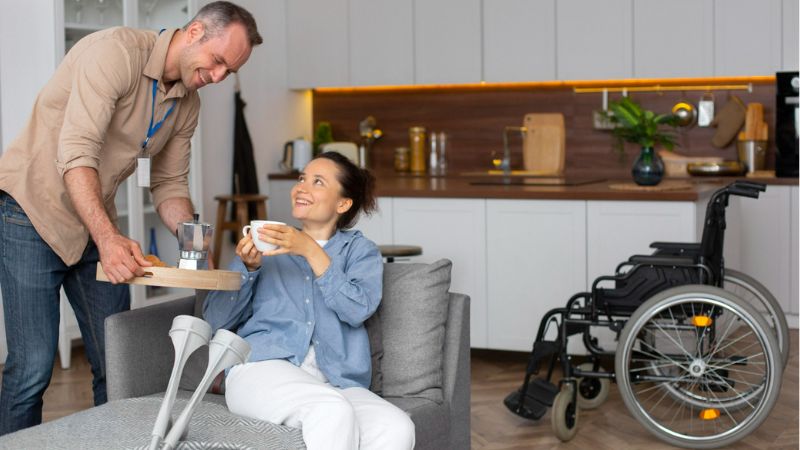
Envision a home that is not only a haven of comfort but also a fortress of safety for those who reside within. For participants in the Consumer Directed Personal Assistance Program (CDPAP), the home is more than a living space—it’s the primary caregiving environment.
Here, safety transcends basic necessity, evolving into a critical component of effective care. This guide is designed to walk you through essential safety checks that every CDPAP home should implement to protect both caregivers and recipients from potential hazards, thereby fostering a secure and nurturing environment for care to thrive.
The Importance of Home Safety in CDPAP
Understanding the CDPAP Framework
In CDPAP, recipients have the unique opportunity to manage their care by choosing caregivers who are often family members or close friends. This level of personal involvement requires a home setting that is adapted to meet the medical and functional needs of the recipient.
Why Focus on Safety?
A safe home environment minimizes risks of accidents and injuries, enhances the quality of care, and supports the independence of the care recipient. It also reduces stress for the caregiver, knowing that preventable hazards have been addressed.
Comprehensive Safety Checks for a CDPAP Home
General Home Safety
- Smoke and Carbon Monoxide Detectors: Ensure that these devices are installed and functioning properly. Check batteries regularly and consider interconnected detectors that can trigger simultaneously.
- Fire Extinguishers: Have at least one fire extinguisher on each floor, especially near the kitchen, and ensure caregivers know how to use them.
- Clear Pathways: Keep all pathways clear of clutter to prevent falls, particularly in high-traffic areas.
Bathroom Safety
- Install Grab Bars: Place grab bars in the shower, bathtub, and near the toilet to assist with mobility and prevent falls.
- Nonslip Mats: Use nonslip mats inside and outside the shower or tub and near the sink area.
- Raised Toilet Seats: For recipients with mobility issues, consider a raised toilet seat with handles for easier access.
Kitchen Safety
- Safe Storage: Keep all sharp objects and hazardous materials out of reach or securely locked away.
- Appliance Checks: Regularly check appliances for proper function and wear. Make sure all appliances are easily accessible and safe to use.
- Emergency Procedures: Establish a clear plan for emergencies, including cooking fires or gas leaks.
Bedroom Safety
- Proper Bed Height: Ensure the bed is at a safe height for easy access, which helps prevent falls when getting in or out of bed.
- Emergency Accessibility: Keep a phone with emergency numbers and a flashlight by the bed in case of power outages or emergencies during the night.
Medication Safety
- Secure Storage: Store medications in a secure, organized manner to prevent misuse and to ensure they are easily accessible when needed.
- Regular Reviews: Periodically review medication expiry dates and proper storage requirements with healthcare providers.
Accessibility and Mobility
- Ramps and Lifts: If stairs are a barrier, consider installing ramps or lifts to facilitate mobility around the home.
- Furniture Arrangement: Arrange furniture to create ample space for mobility aids such as walkers and wheelchairs.
Tools and Resources to Enhance Home Safety
Technology and Monitoring
Consider the use of home monitoring systems that can alert caregivers to potential issues, such as falls or unusual activity, especially when they are not physically present.
Professional Assessments
Engage a professional to assess the home environment. Occupational therapists can provide tailored recommendations to enhance safety based on the recipient’s specific health needs.
In the CDPAP program, where care recipients have significant control over their caregiving dynamics, ensuring a safe home environment is crucial. By conducting these essential safety checks, caregivers can create a space that not only supports the physical health of the recipient but also provides peace of mind. Safety is not a one-time task but an ongoing commitment. Regularly revisiting and updating safety measures as the recipient’s needs evolve is key to maintaining an optimal caregiving environment.
Tailoring Home Environments for Better Mobility in CDPAP Homecare

Imagine a home where every corner is a haven that supports mobility and independence. For those enrolled in the Consumer Directed Personal Assistance Program (CDPAP), this is not just a luxury but a necessity.
Tailoring home environments for better mobility not only enhances the quality of life for homecare recipients but also fosters a sense of dignity and independence. This blog explores the practical steps and considerations for adapting home spaces to suit the mobility needs of CDPAP homecare patients, integrating medical insights with everyday practicality.
Understanding Mobility Challenges in CDPAP Homecare
The Basics of Mobility Impairment
Mobility impairments can vary widely, from temporary injuries to long-term disabilities. In the context of CDPAP, where patients direct their care, understanding these impairments is crucial for creating a supportive home environment.
Common Causes of Reduced Mobility
Several medical conditions can impair mobility, including neurological disorders, musculoskeletal pain, and age-related muscle degeneration. Each condition requires a unique approach to home modification.
Strategies for Enhancing Home Mobility
Safe Flooring Solutions
The choice of flooring can significantly affect a patient’s ability to move safely at home. Options like slip-resistant flooring and well-placed rugs can prevent falls and facilitate easier movement.
Accessibility in Furniture Arrangement
Furniture should be arranged to create clear pathways. This section discusses optimal furniture placement strategies that enhance mobility while maintaining a cozy home aesthetic.
Utilizing Adaptive Tools and Technology
From stairlifts to smart home systems, technology can greatly enhance home mobility. This part explores various adaptive tools that can be incorporated into the home care setting.
Tailoring Spaces for Specific Mobility Needs
Bathroom Modifications for Safety and Comfort
The bathroom is often the most hazardous room for those with mobility issues. Here, we delve into modifications such as grab bars, nonslip mats, and accessible shower designs.
Kitchen Adjustments for Easy Accessibility
Modifying a kitchen to be more accessible can help CDPAP recipients maintain their independence. This includes lower countertops and accessible storage solutions.
Bedroom Modifications for Better Support
The bedroom should be a place of rest and recovery. We will discuss how to optimize this space for safety and comfort, focusing on bed height, emergency call systems, and lighting.
Integrating Caregiver Needs into Home Design
Ensuring Caregiver Accessibility
While the focus is often on the recipient, caregivers also need an environment that aids them in providing care. This includes ergonomic considerations to prevent caregiver injuries.
Communication Enhancements for Better Care
Effective communication between caregiver and recipient is crucial. This section outlines tools and strategies to enhance communication, from intercom systems to wearable devices.
Overcoming Common Barriers to Home Modification
Financial Considerations
Often, the biggest barrier to home modifications is cost. This section provides information on potential funding sources and budgeting tips for home adaptations.
Navigating Regulations and Compliance
Home modifications can be subject to various regulations. Here, we explain how to comply with local codes and standards while making necessary home adjustments.
Evaluating the Impact of Home Modifications on Mobility
Personal Stories of Enhanced Mobility
Drawing from firsthand accounts, this section highlights the positive changes that tailored home environments have brought to individuals in the CDPAP program.
Professional Insights on Mobility Improvements
Healthcare professionals weigh in on the benefits of specific home modifications, providing a deeper understanding of their impact on mobility and independence.
Adapting a home for better mobility under the CDPAP program is not just about making physical changes. It’s about transforming a space to nurture the independence and well-being of its occupants. With thoughtful planning and strategic modifications, caregivers and care recipients can create a living space that not only meets medical needs but also feels like a true home.
What to Expect When You're New to CDPAP

Stepping into the world of the Consumer Directed Personal Assistance Program (CDPAP) can feel like navigating a new city without a map. Whether you are a potential patient or a caregiver, understanding the contours of CDPAP will not only alleviate your initial anxieties but also empower you to make the most of this unique program.
This blog post serves as your guide through the essentials of the CDPAP, offering you the knowledge and tools to confidently manage your healthcare journey.
About CDPAP: A Brief Overview
The CDPAP Model
CDPAP is a Medicaid program that allows individuals requiring medical assistance to appoint and direct their caregivers. This model promotes autonomy and personalization in home care settings.
Eligibility and Enrollment
Who qualifies for CDPAP? This section delves into the eligibility criteria and the enrollment process, providing a clear pathway for prospective participants.
The Role of Personal Assistants
Choosing the Right Caregiver
How do you select a caregiver who not only meets your medical needs but also fits seamlessly into your personal life? Here, we explore the qualities to look for in a potential caregiver.
Duties and Responsibilities
What can CDPAP caregivers do? From medical tasks to everyday assistance, this part outlines the comprehensive role of a CDPAP caregiver.
Navigating the Financial Aspects
Understanding Compensation
One of the unique aspects of CDPAP is the way caregivers are compensated. This section breaks down the financial logistics, including how caregivers are paid.
Budget Management
Managing finances within the CDPAP can be challenging. Learn effective strategies to ensure financial health while receiving care.
Legal and Compliance Requirements
Regulatory Overview
Stay informed about the laws and regulations that govern the CDPAP program. Knowing these can help you avoid common pitfalls and ensure the program works in your favor.
Maintaining Compliance
Compliance is key in CDPAP. This section provides tips on keeping your care within legal bounds, ensuring that both patient and caregiver rights are protected.
Preparing Your Home for CDPAP Care
Home Safety Modifications
A safe home environment is crucial for effective care. Here, we cover essential modifications that might be needed to accommodate medical equipment or mobility aids.
Creating a Conducive Care Environment
Beyond safety, comfort is vital. Learn how to create a home setting that enhances the well-being of both the caregiver and the care recipient.
The Emotional Journey
Adjusting to New Dynamics
Introducing a caregiver into your home changes dynamics. We discuss how to handle these emotional transitions and maintain a healthy relationship.
Support Systems and Resources
No one should navigate CDPAP alone. This section highlights support systems available for both caregivers and recipients, including community groups and counseling services.
Evaluating Care Quality
Feedback Mechanisms
Continuous improvement is crucial. Learn how to implement and use feedback mechanisms to improve the care quality in your CDPAP arrangement.
Professional and Peer Reviews
What do professionals and current participants say about CDPAP? Insights from these reviews can guide new participants in making informed decisions.
Being new to CDPAP is the beginning of a profound journey towards personalized healthcare. By understanding what to expect and preparing adequately, both caregivers and care recipients can look forward to a fulfilling experience that upholds dignity and promotes independence. Welcome to a world where your care is truly in your hands.
Seasonal Wellness Tips for CDPAP Caregivers and Recipients

As the seasons change, so do our health needs. Whether you are a caregiver or a care recipient, adapting your wellness routine to fit the season can significantly enhance your health and well-being. From the blossoms of spring to the frosty days of winter, each season brings unique challenges and opportunities for health.
Spring into Health:
Allergy Management
Spring is notorious for its pollen-laden air, which can exacerbate allergies. Tips on managing seasonal allergies with over-the-counter remedies, natural therapies, and maintaining an allergen-free home environment are crucial for uninterrupted care.
Revitalizing Outdoor Activities
The warmer weather and longer days are perfect for incorporating outdoor exercises into your routine. We’ll explore activities that are both enjoyable and suitable for varying levels of mobility, such as light walking or chair yoga in the park.
Summer’s Radiant Wellness:
Hydration and Nutrition
Staying hydrated and eating well is vital during the hot summer months. This section will provide nutritional advice tailored to beat the heat, including hydrating foods and the importance of a balanced diet rich in fruits and vegetables.
Sun Safety
Protecting skin from harmful UV rays is essential. Learn about the best practices for sun safety, including the use of sunscreen, wearing appropriate clothing, and the best times to enjoy the sun safely.
Autumn Adjustments:
Immune System Boosts
As temperatures drop, boosting the immune system becomes key. We’ll cover dietary supplements, foods rich in vitamins C and D, and other lifestyle adjustments to help ward off the common cold and flu.
Mental Health as Nights Lengthen
The shorter days of autumn can affect mood, particularly for those who spend most of their time indoors. Strategies to combat seasonal affective disorder (SAD) and maintain mental health through engaging indoor activities will be discussed.
Winter Wellness:
Cold Weather Safety
Cold weather presents unique challenges, including increased risk of hypothermia and joint pain exacerbation. Tips will include how to dress warmly, optimize indoor heating, and safely navigate slippery conditions.
Combatting Inactivity
With fewer opportunities for outdoor exercise, finding ways to stay active indoors is crucial. We’ll provide creative solutions for maintaining physical activity levels, even in confined spaces.
Year-Round Caregiver Self-Care:
Managing Stress
Caregiving can be stressful regardless of the season. This section focuses on effective stress management techniques, such as mindfulness, and meditation, and the importance of taking regular breaks.
Networking and Support
Building a support network is essential for caregiver resilience. Tips on finding local support groups, online communities, and other resources where caregivers can share experiences and advice will be outlined.
Adapting Home Environments for Seasonal Changes:
Temperature and Humidity Control
Maintaining an optimal home environment affects both comfort and health. Solutions for managing indoor air quality and proper heating and cooling will be explored to ensure a safe and comfortable home year-round.
Safe and Healthy Home Habits
This section will provide practical tips on keeping the home environment clean and free from hazards, which is especially important for those with limited mobility or health conditions.
Adapting to the rhythm of the seasons doesn’t just align you with nature—it can also play a crucial role in maintaining health and wellness for both caregivers and care recipients. By implementing these seasonal wellness tips, you can ensure that both you and those you care for not only cope with seasonal changes but also flourish throughout the year.
The Importance of Regular Check-Ups in CDPAP Care

Imagine a world where every potential health issue could be caught before it spirals into a major problem. This isn’t just a hopeful scenario in the realm of (CDPAP) care—it’s a critical system component. Regular check-ups are the cornerstone of preventive healthcare, serving as a vital tool to ensure that caregivers and recipients can maintain not just the status quo, but an optimal state of health.
Understanding CDPAP and Its Unique Demands:
A Quick Overview of CDPAP
CDPAP allows individuals needing care to choose and direct their caregivers instead of using professionals from home care agencies. This model emphasizes personal choice and flexibility but also requires vigilant health management.
The Dual Role in CDPAP
Caregivers in CDPAP are often family members who may not have formal medical training. Regular check-ups become essential, not just for the medical well-being of the recipient but also to guide these caregivers in providing the best possible care.
Benefits of Regular Check-Ups in CDPAP:
Early Detection of Health Issues
Regular health assessments help catch diseases before they develop into serious conditions. This section discusses how early detection through consistent medical check-ups can lead to better health outcomes and reduce the risk of emergency interventions.
Management of Chronic Conditions
Many CDPAP recipients live with chronic conditions that require ongoing monitoring. Regular check-ups ensure these conditions are managed effectively and adjustments are made as necessary.
Medication Reviews and Adjustments
Medication regimes often need tweaking to align with changing health conditions. Regular check-ups provide an opportunity to review and adjust medications under professional supervision to avoid potential side effects and interactions.
Structuring Regular Check-Ups for Optimal Care:
What to Include in a Check-Up
This part details the essential components of a comprehensive check-up for CDPAP care recipients, including physical exams, mental health assessments, and screenings for common conditions.
Creating a Check-Up Schedule
How often should check-ups occur? Here, we outline a recommended schedule based on various health needs and conditions, providing a template that caregivers can adapt.
Integrating Check-Ups with Care Plans
Integrating regular medical check-ups into the overall care plan helps maintain continuity and quality of care. This section offers strategies for making check-ups a routine part of the care regimen.
Challenges and Solutions:
Overcoming Barriers to Regular Care
Transportation, financial constraints, and caregiver availability can all hinder regular medical visits. This section provides practical solutions to overcome these barriers.
Leveraging Technology in Check-Ups
Telehealth and other technological advancements have made it easier to conduct some aspects of check-ups remotely. We explore how these tools can be integrated into regular CDPAP care routines.
The Impact of Regular Check-Ups on Caregiver Well-being:
Educating and Empowering Caregivers
Regular check-ups also serve an educational purpose for caregivers, offering them insights and knowledge about the health conditions they manage.
Stress Reduction Through Professional Support
Knowing that a professional is regularly evaluating and advising on the care recipient’s health can alleviate the stress often associated with caregiving responsibilities.
In the world of CDPAP, where the lines between professional and personal care blend, regular check-ups are not just beneficial—they are essential. They ensure that care recipients receive the best possible attention while empowering caregivers with the knowledge and support they need. Embrace the practice of regular check-ups to elevate the quality of care and ensure that health management is proactive, not reactive.
How to Use Technology to Enhance Caregiving
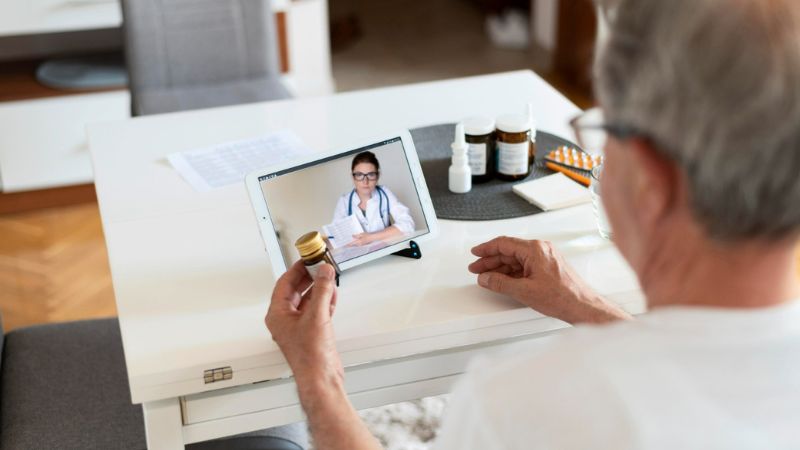
In the fast-paced world of healthcare, caregivers are constantly seeking ways to enhance the quality and efficiency of the care they provide. Technology, with its rapid advancements, offers unprecedented opportunities to revolutionize caregiving.
From digital health records and telemedicine to AI-powered diagnostic tools and mobile health apps, technology can streamline many caregiving tasks, allowing caregivers to spend more quality time with patients. This blog explores how caregivers can harness these technological tools to improve patient outcomes, enhance communication, and optimize healthcare workflows.
Harnessing Digital Health Records
Digital health records (EHRs) are at the forefront of healthcare technology. By centralizing patient data, EHRs enable caregivers to access and share vital health information swiftly, ensuring that every medication, diagnosis, and past treatment is thoroughly documented and easily retrievable. This reduces errors, saves valuable time, and supports better patient outcomes.
The Power of Telemedicine
Telemedicine has transformed access to healthcare, especially in rural or underserved areas where medical expertise may be scarce. Video consultations, remote monitoring tools, and mobile health applications allow caregivers to provide real-time care and advice, regardless of their physical location. This not only improves access to healthcare services but also reduces the strain on patient mobility and caregiver workload.
AI and Machine Learning in Caregiving
Artificial Intelligence (AI) and machine learning are redefining predictive healthcare. AI algorithms can analyze vast amounts of data from EHRs to predict patient risks and outcomes more accurately. For caregivers, this means being able to identify potential health issues before they become critical, enabling proactive care rather than reactive treatment.
Mobile Health Apps
Mobile health apps offer caregivers and patients tools to manage their health daily. These apps can track medication schedules, remind patients of upcoming doctor’s appointments, and even monitor health metrics like blood pressure and glucose levels. For caregivers, these apps are invaluable in managing the day-to-day health of their charges efficiently.
Integrating Smart Home Technology
Smart home technology, such as voice-activated devices and automated home monitoring systems, can provide caregivers with extra support in home-care settings. These technologies help monitor patient activity levels, send alerts if a patient falls, and even control home environments to assist patients with mobility issues.
Virtual Reality and Augmented Reality
Virtual reality (VR) and augmented reality (AR) are on the cutting edge of caregiver training and patient therapy. VR can simulate real-life scenarios for caregiver training without the risks, enhancing skills in a controlled environment. AR can be used in patient care to explain complex procedures or changes in health conditions, enhancing understanding and cooperation.
Embracing technology in caregiving isn’t just about keeping up with trends—it’s about actively improving the quality of care provided to patients while easing the physical and emotional load on caregivers. As we move forward, these technologies will become increasingly integral to healthcare, making now the perfect time for caregivers to adapt and embrace these changes. By integrating smart technology into your caregiving approach, you can enhance your ability to care and transform your caregiving process into a more effective, efficient, and compassionate practice.
Caregivers and healthcare providers must stay informed about the latest advancements and think creatively about how technology can fit into their caregiving strategy. With the right tools, the future of caregiving can be smarter, more efficient, and more patient-centered than ever before.
Organizing Your Home for Efficient CDPAP Care

Turning your home into a well-organized caregiving environment is not just about convenience; it’s about creating a space that supports health, wellness, and the unique needs of both the caregiver and the care recipient. For those involved in the Consumer Directed Personal Assistance Program (CDPAP), this is especially crucial. The right environment can significantly enhance the caregiving experience, making daily tasks smoother and ensuring that care recipients receive the best possible support.
Streamlining Spaces for Caregiving
Optimize Your Layout:
The layout of your home can significantly impact the efficiency of care. Ensure that the most frequently used areas are easily accessible to the care recipient. Consider the path of travel within the home—clear any clutter that might pose a hazard and arrange furniture to create wide, navigable pathways. This minimizes the risk of falls and facilitates mobility throughout the space.
Essential Medical Equipment:
Position medical supplies and equipment in strategic locations. For example, keeping a wheelchair accessible beside the bed or having oxygen equipment next to the favorite sitting area ensures that these critical items are always within reach. Use labels and color coding to manage medications and caregiving supplies, which can reduce confusion and save precious time during emergencies.
Enhancing Safety and Accessibility
Safety Modifications:
Install grab bars in the bathroom, along hallways, and in other key areas to help prevent falls. Consider a shower bench and a handheld showerhead to make bathing safer and more accessible. Non-slip mats in the bathroom and kitchen can provide additional safety.
Technology for Better Care:
Utilize technology to enhance caregiving. Medical alert systems can be a lifeline in case of an emergency, allowing the care recipient to notify the caregiver or emergency services with the push of a button. Smart home devices such as voice-controlled lights and thermostats can make it easier for individuals with mobility or vision impairments to control their environment.
Creating a Healing Environment
Peaceful Living Areas:
The living environment should promote relaxation and healing. Use calming colors and soft lighting to create a peaceful atmosphere. Plants can improve indoor air quality and add a touch of nature, which is known to have therapeutic effects.
Personal Space:
Designate a personal area for the care recipient where they can feel comfortable and have a sense of independence. This space can be equipped with personal items, hobbies, and entertainment options that help maintain their happiness and mental health.
Organizational Tools for Caregivers
Documentation Station:
Create a dedicated area for caregiving documentation. This includes care logs, medical records, and schedules. Having all documents in one place ensures that information is readily available when needed, making management of care duties more streamlined.
Regular Reviews and Adjustments:
As needs evolve, the home setup should adapt accordingly. Regularly review the effectiveness of the current organization and make adjustments as the care recipient’s needs change. This proactive approach can prevent issues before they become problems and ensures the caregiving environment remains optimal.
Organizing your home for efficient CDPAP care is more than a one-time setup; it’s a continuous commitment to creating an environment that fosters health, safety, and comfort. By following these tips, caregivers can create a home that not only meets the physical and medical needs of the care recipient but also promotes a holistic approach to care that values emotional and psychological well-being. With thoughtful organization and ongoing attention to detail, caregivers can significantly enhance the quality of care and make a profound impact on the lives of those they serve.
Tips for Handling Emergency Situations

Navigating through emergencies effectively is crucial in any healthcare setting, but it becomes particularly significant in CDPAP environments. This program allows patients, or consumers, to direct their care by hiring family members, friends, or previous caregivers who are familiar with their needs, which can add a layer of personalization and comfort not found in traditional home care settings.
However, this setup also requires the caregivers to be well-prepared for potential emergencies. Below, we provide comprehensive insights and actionable strategies to empower CDPAP caregivers in managing urgent medical or health crises adeptly.
Understanding the CDPAP Framework
Before diving into the emergency protocols, it’s essential to grasp the unique aspects of CDPAP. This program hinges on the autonomy it grants consumers in their care, allowing them to choose caregivers who are not necessarily medically trained professionals but who possess intimate knowledge of the consumer’s medical and personal needs. The duality of personal familiarity and professional responsibility in CDPAP underscores the need for preparedness and proper emergency management strategies.
Recognizing Common Emergencies in Home Care
- Medical Emergencies: From sudden acute conditions like heart attacks or strokes to accidents such as falls, CDPAP caregivers must be vigilant and responsive.
- Healthcare Crises: These include rapid deterioration of chronic conditions like diabetes or respiratory diseases that might necessitate immediate intervention.
- Mental Health Concerns: Emotional or psychological distress can also present urgent situations that need to be managed with sensitivity and promptness.
Preparation: The Key to Effective Emergency Response
- Training and Education: Ensure that all caregivers have basic training in first aid, CPR, and emergency response specific to the consumer’s known health issues.
- Emergency Kits: Always have accessible, well-stocked emergency kits that include medical supplies, medications, and critical health information.
- Practice Drills: Regularly run through emergency scenarios to keep everyone prepared and confident in their ability to respond swiftly and effectively.
Actionable Steps During an Emergency
- Stay Calm and Assess the Situation: Keeping a cool head will allow you to assess the situation more accurately and communicate more effectively with emergency services.
- Provide Necessary First Aid: Utilize your training to provide immediate care. This could range from administering CPR to stopping blood loss.
- Contact Emergency Services: Time is often of the essence, so contact emergency services as soon as you assess the need for professional intervention.
- Inform the Consumer’s Healthcare Team: If the situation allows, inform the consumer’s doctor or healthcare team of the emergency as soon as possible.
Communication Strategies in Urgent Situations
Clear and calm communication during an emergency with the patient, family members, and medical professionals can make a significant difference in the outcome. Ensure that you have all necessary contact information readily available, and maintain a composed demeanor to help keep the consumer calm as well.
Post-Emergency Protocols
After an emergency, it’s crucial to review the incident to improve future responses. This could involve updating emergency plans, replenishing supplies, or additional training sessions for caregivers. Regularly revisiting and revising emergency procedures ensures continued efficacy and preparedness.
Handling emergencies in a CDPAP setting involves more than just quick reactions; it requires a deep understanding of both the patient’s needs and the legal framework within which the caregiver operates. By fostering an environment of preparation and education, CDPAP caregivers can ensure not only the safety and well-being of their clients but also their peace of mind. Remember, the right knowledge and a calm approach can make all the difference when seconds count.
The Impact of Social Activities on CDPAP Recipients

In the realm of home care, particularly under CDPAP, the influence of social activities on recipients’ overall health and well-being is profound. Unlike traditional home care models, CDPAP empowers recipients by allowing them to choose caregivers from their community, often turning daily care into an opportunity for meaningful social interaction.
Understanding CDPAP and Its Community-Centric Approach
CDPAP is a unique model in the landscape of healthcare that emphasizes the autonomy of individuals needing care. This program not only facilitates personalized caregiver selections but also inherently encourages a community-centric approach to health management. Here, social integration becomes not just a possibility but a fundamental aspect of the care recipients’ daily lives.
The Psychological Benefits of Social Interaction
- Enhancing Mental Health: Regular social interactions can significantly reduce feelings of depression and anxiety among the elderly and disabled, common cohorts in the CDPAP system.
- Cognitive Benefits: Engaging with others in meaningful activities can help maintain cognitive functions, slowing the progression of cognitive decline associated with conditions like dementia and Alzheimer’s disease.
The Physical Health Advantages of Social Activities
- Increased Physical Activity: Social interactions often involve physical activities that can help improve mobility, flexibility, and overall physical health.
- Better Health Management: Social support can also lead to better health management, as peers often encourage one another to adhere to medical guidelines and maintain regular doctor visits.
Social Activities as a Gateway to Enhanced Emotional Well-Being
The emotional uplift that comes from being an active part of a community cannot be overstated. For CDPAP recipients, who often spend considerable amounts of time in isolation, being socially active can reignite a sense of purpose and belonging, critical components of emotional health.
Barriers to Social Integration for CDPAP Recipients
Despite the benefits, there are significant barriers that can prevent CDPAP recipients from becoming socially active. These include physical limitations, lack of accessible transportation, and social anxiety. Addressing these barriers is crucial in facilitating the full spectrum of benefits that social activities can offer.
Strategies to Enhance Social Engagement in CDPAP Care
- Community Programs and Events: Organizing and participating in events that cater to the interests and abilities of CDPAP recipients can greatly enhance their social engagement.
- Technology Integration: Utilizing technology to bridge the gap between CDPAP recipients and their communities can also play a pivotal role, especially for those confined to their homes.
Case Studies: Real-Life Success Stories
This section could explore several case studies where CDPAP recipients experienced significant improvements in their quality of life through regular social activities, providing practical examples of successful social integration.
The role of social activities in enhancing the lives of CDPAP recipients is undeniable. Not only do these activities improve mental and physical health, but they also enrich the recipients’ lives with joy and a renewed sense of community. For CDPAP caregivers and recipients alike, fostering an environment where social engagement is a priority can transform the caregiving experience from a duty to a dynamic, integrative community effort.
Empowering Independence: How CDPAP Supports Self-Care and Self-Management
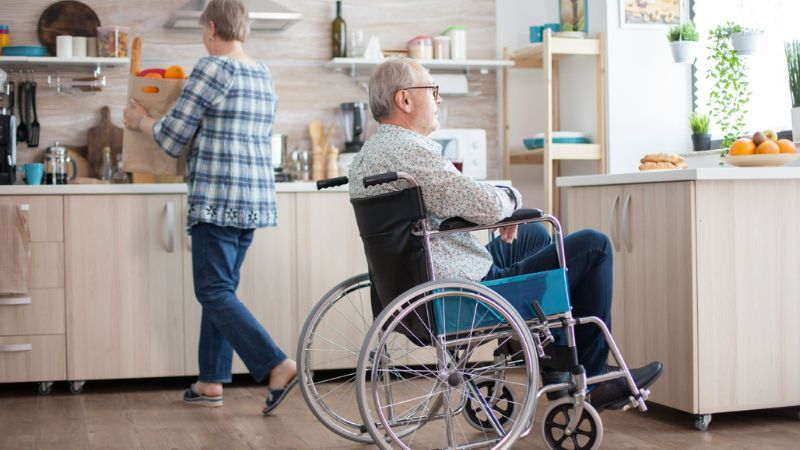
In the intricate landscape of healthcare, independence is a beacon that lights the way toward empowerment and self-sufficiency. The Consumer Directed Personal Assistance Program (CDPAP), a pioneering initiative in the field of home healthcare, champions this vision by enabling individuals requiring assistance to take charge of their care.
This approach not only revolutionizes traditional patient-caregiver dynamics but also reinstates a sense of autonomy for those who might feel sidelined by their health conditions.
Empowerment Through Choice
At the heart of CDPAP is the principle of choice. The power to choose who cares for you and how they do it not only reinforces autonomy but also enhances the quality of care received. This section explores the transformative impact of this choice on patient empowerment and the overall caregiving experience.
Navigating Self-Care with CDPAP
Self-care is an integral part of managing any health condition. CDPAP uniquely facilitates this by enabling consumers to tailor their care according to their personal needs and preferences. This segment outlines practical ways in which consumers utilize CDPAP to maximize their self-care routines, promoting better health outcomes and a greater sense of well-being.
CDPAP’s Role in Chronic Disease Management
Chronic diseases require continuous care and meticulous management. CDPAP empowers consumers to integrate their lifestyle and medical care in ways that conventional home care models may restrict. Here, we examine CDPAP’s effectiveness in chronic disease management through consumer-directed care.
Training and Support in CDPAP
While CDPAP promotes independence, it also ensures support is at hand. This part discusses the training and resources available to consumers and their assistants, ensuring they are well-equipped to handle the demands of care management effectively.
Legal and Financial Aspects of CDPAP
Understanding the legal and financial facets of CDPAP is crucial for anyone considering the program. This section provides an overview of the essential legalities and financial implications involved in enrolling and participating in CDPAP.
Personal Stories of Independence and Care
Real-life testimonials and stories from those who have benefitted from CDPAP can inspire and inform prospective consumers. This narrative section will share several powerful examples of how CDPAP has facilitated self-management and independence in the lives of real people.
Comparing CDPAP with Traditional Home Care Services
To appreciate the uniqueness of CDPAP, it is helpful to compare it with traditional home care models. This comparative analysis will highlight the differences in approach, benefits, and limitations of each model.
How to Enroll in CDPAP
For those interested in CDPAP, knowing how to get started is essential. This practical guide will walk through the enrollment process, eligibility criteria, and necessary steps to begin receiving care through CDPAP.
The Future of CDPAP and Home Healthcare
Looking forward, what does the future hold for CDPAP and home healthcare? This forward-looking section predicts trends and developments that could shape the landscape of consumer-directed care in the years to come.
The Path Toward Health Autonomy
CDPAP not only supports practical aspects of healthcare but also encourages a philosophical shift towards patient autonomy and empowered self-care. This concluding section will reflect on how CDPAP represents a significant step forward in the evolution of patient-centered healthcare.
Emotional Benefits of Home-Based Care for Chronic Illnesses

Navigating the stormy seas of chronic illness involves much more than managing physical symptoms; it also includes addressing the emotional and psychological tolls that these diseases can take. Home-based care, a compassionate approach to medical treatment, offers a sanctuary where patients can receive professional care in the comforting embrace of their familiar surroundings.
This type of care not only alleviates physical discomfort but also substantially enriches emotional well-being.
About Home-Based Care
Home-based care refers to medical and therapeutic services provided in a patient’s home to manage the complexities of chronic illnesses. This segment will outline what home-based care involves and who typically utilizes these services, setting the stage for a deeper exploration of its emotional impacts.
The Comfort of Familiar Surroundings
The healing power of being in a familiar environment cannot be overstated. This section discusses how home-based care helps maintain patients’ daily routines and the emotional stability these routines provide, which is especially critical for those enduring long-term healthcare challenges.
Reducing Emotional and Physical Stress
Traveling to and from medical facilities can be a significant source of stress for patients with chronic conditions. Home-based care eliminates this need, significantly reducing stress levels and promoting a peaceful healing environment. Here, we explore the psychological benefits of minimizing these stressful outings.
Enhanced Patient Autonomy and Empowerment
One of the most significant emotional benefits of home-based care is the sense of autonomy and empowerment it provides to patients. This part delves into how being involved in one’s care decisions and maintaining independence can positively affect mental health and overall emotional resilience.
Strengthens Family Bonds
Home-based care often involves family members in the caregiving process, thereby strengthening emotional bonds. This section will examine how shared responsibilities can enhance relationships and provide psychological comfort to both the patient and family members.
Personalized Care and Attention
Unlike the often generic care in institutional settings, home-based care allows for highly personalized medical attention. This segment will discuss how tailored care plans address not just the medical but also the emotional needs of patients, fostering a deeper caregiver-patient relationship.
Continuity of Care
Continuity is crucial in managing chronic illnesses. Home-based care ensures that patients see a consistent team of caregivers, which can enhance trust and emotional security. This part explores the impact of having a dedicated care team on a patient’s emotional well-being.
The Role of Technology in Home-Based Care
Advancements in healthcare technology have made it easier to administer sophisticated medical treatments at home. This section highlights how technology enhances home-based care and supports emotional health by providing patients with security and innovative ways to manage their health.
Navigating Challenges in Home-Based Care
While home-based care has many benefits, it also comes with its challenges, such as the potential for family caregiver burnout and the logistics of home modifications. Here, we will discuss these challenges and offer solutions to manage them effectively.
Testimonials and Success Stories
Real-life stories resonate deeply and can encourage those considering home-based care. This narrative section will share touching testimonials from patients and families who have experienced the emotional benefits of this care setting.
Home-based care embodies a holistic approach to health management, one that nurtures the physical and emotional needs of patients. The conclusion will reflect on the transformative potential of home-based care and its role in pioneering a more compassionate and patient-centric healthcare paradigm.
The Role of Caregivers in Enhancing Quality of Life for Elderly Patients

As the golden years roll in, the need for quality care becomes paramount in ensuring that elderly individuals enjoy this phase of their lives with dignity and happiness. Caregivers play an indispensable role in this endeavor, acting not just as providers of medical care but as crucial pillars of emotional support and daily life management.
Understanding the Needs of Elderly Patients
The first step in appreciating the role of caregivers is understanding the specific needs of elderly patients. These needs often extend beyond medical care to include emotional support, mobility assistance, and help with daily activities. This section delves into the common challenges faced by the elderly and the comprehensive care required to address these needs effectively.
Comprehensive Care: More Than Just Medical Assistance
Caregivers provide a spectrum of services that encompass both medical and non-medical care. From administering medications to assisting with personal hygiene and providing companionship, this segment explores the diverse responsibilities of caregivers and how these tasks contribute to enhancing the overall well-being of elderly patients.
Emotional and Social Support
Loneliness and social isolation can severely affect the health of elderly individuals. Caregivers often become a social and emotional lifeline for their patients. Here, we examine the impact of emotional support and regular social interaction provided by caregivers on the mental health and quality of life of elderly patients.
Promoting Independence Among the Elderly
One of the key roles of caregivers is to encourage independence in elderly patients as much as possible. This section discusses the techniques caregivers use to foster self-reliance while ensuring safety, which can significantly enhance the elderly’s sense of autonomy and self-worth.
Customized Care Plans
Every elderly patient is unique, requiring personalized care tailored to their specific health conditions and preferences. This part outlines how caregivers develop and implement customized care plans that address the individual needs of each elderly patient, thereby optimizing their health outcomes and quality of life.
Training and Qualifications of Professional Caregivers
The effectiveness of a caregiver’s role can be greatly influenced by their training and qualifications. This segment highlights the importance of professional development in geriatric care and how trained caregivers are better equipped to handle the complex needs of elderly patients.
Technology and Caregiving
Modern technology has transformed caregiving, making it more efficient and responsive. From telemedicine to health monitoring devices, this section explores how technological advancements support caregivers in enhancing the care and safety of elderly patients.
The Challenges Caregivers Face
While the role of caregivers is incredibly rewarding, it also comes with its challenges, including emotional and physical strain. Here, we discuss the common challenges caregivers face, the importance of caregiver support networks, and strategies for managing caregiver stress.
Legal and Ethical Considerations in Elderly Care
Caregiving is bound by legal and ethical considerations that protect the well-being and rights of both patients and caregivers. This section covers the critical legal and ethical guidelines that govern caregiving practices, ensuring respectful and lawful care.
Real-Life Impact: Testimonials from Families
Hearing from families who have witnessed the positive impact of caregivers on their elderly loved ones can be powerful. This narrative part shares testimonials that illustrate the transformative role caregivers have played in enhancing the quality of life for the elderly.
Caregivers are the unsung heroes in healthcare, especially in the domain of elderly care. This concluding section reflects on the pivotal role they play, not just in maintaining health but in enhancing the day-to-day lives of elderly individuals, making their golden years more joyful and fulfilling.
Innovative Home Care Strategies for Patients with Multiple Sclerosis
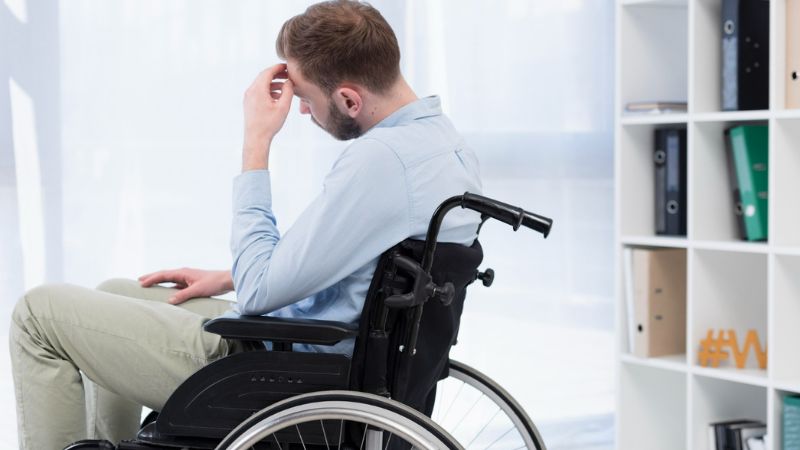
Living with Multiple Sclerosis (MS) is an ongoing challenge that affects not just the physical body but also emotional health and daily lifestyle. This disease of the central nervous system can lead to unpredictable symptoms such as fatigue, mobility issues, and cognitive impairments, making everyday activities daunting. While there is no cure, there are numerous strategies to manage symptoms and improve quality of life.
Adapting the Living Space
Accessibility is Key:
Adjusting your home for wheelchair access if necessary is paramount. This includes installing ramps, widening doorways, and ensuring that flooring is smooth and non-slip. Additionally, reducing clutter and rearranging furniture can create clear pathways and easier navigation.
Safe and Accessible Bathroom Modifications:
Installing grab bars, a walk-in bathtub, or a seat in the shower can significantly reduce the risk of falls. Non-slip mats and a handheld shower head can also make bathing safer and more manageable.
Smart Home Technology:
Utilizing voice-activated systems for lights, thermostats, doors, and entertainment devices can help those with limited mobility maintain their independence. Smart home tech can also include remote monitoring systems that help caregivers keep an eye on their loved ones, even from afar.
Ergonomic Enhancements
Tailored Furniture:
Invest in ergonomic furniture that supports posture and comfort. Adjustable beds and chairs that offer good support can prevent fatigue and make it easier to stand up and sit down.
Adaptive Utensils and Tools:
Ergonomically designed kitchen tools and eating utensils adapted for reduced hand and grip strength can restore autonomy in eating and cooking, crucial areas of daily life that MS can disrupt.
Incorporating Physical and Occupational Therapy
Routine Exercise:
Engage in daily exercise routines that are specifically designed for MS patients. These can include yoga, swimming, or light aerobic exercises to enhance muscle strength and flexibility, reduce stiffness, and boost mood.
Occupational Therapy at Home:
An occupational therapist can tailor activities and therapeutic strategies to improve the functionality and independence of MS patients. They can assess the living environment and suggest modifications to aid in daily tasks like dressing, cooking, and personal care.
Emotional and Social Support
Build a Support Network:
Staying connected with friends, family, and local support groups can provide emotional support and practical help. Emotional health is crucial in managing MS, and a strong support network can combat feelings of isolation or depression.
Mental Health Resources:
Professional counseling and therapy can also be beneficial. Cognitive-behavioral therapy (CBT) and other therapeutic approaches can help manage the psychological impacts of living with a chronic condition like MS.
Advanced Planning for Flare-Ups
Emergency Kits:
Prepare emergency kits with necessary medications, instructions, and medical contact information readily available. This is particularly important for managing sudden MS flare-ups or other medical issues that require quick action.
Caregiver Instructions:
Maintain a set of written instructions for caregivers on managing routine care and emergencies. This ensures everyone involved in care is informed and can provide the best support during critical times.
Implementing these innovative home care strategies can make a significant difference in the lives of those affected by Multiple Sclerosis. While adapting a home and daily routine takes time and effort, the resulting comfort, safety, and independence are invaluable. Remember, each person’s needs and preferences are different; it’s important to tailor these strategies to fit the specific requirements of the individual.
Navigating life with Multiple Sclerosis is undoubtedly challenging, but with the right modifications and support, living well is entirely possible. By rethinking home care, patients and caregivers can create a supportive environment that not only mitigates the physical constraints of MS but also fosters a sense of control and optimism.
Exploring the Long-Term Benefits of Consumer-Directed Care Models

In the complex tapestry of modern healthcare, where impersonal and standardized treatments often leave patients feeling sidelined, a different model of care is making waves—one that places the reins of healthcare decisions firmly in the hands of the patients themselves. This model, known as consumer-directed care (CDC), represents a paradigm shift towards patient autonomy and personalized care.
What is Consumer-Directed Care?
Consumer-directed care is a healthcare model that emphasizes patient choice and control. It allows patients, particularly those with chronic conditions or long-term care needs, to make decisions about the type of care they receive and who provides it. This model contrasts sharply with traditional care models, where decisions are predominantly made by healthcare providers.
The CDC model is built on the foundation of self-direction, with financial management supports (like budget allocations) and personalized care plans tailored to individual needs. It’s particularly prevalent in home care scenarios, mental health services, and chronic disease management, where ongoing, personalized care is crucial.
Core Benefits of Consumer-Directed Care
Enhanced Patient Satisfaction
The cornerstone of CDC is its patient-centered approach, which inherently boosts patient satisfaction. By involving patients in their care decisions, CDC fosters a sense of ownership and control, which is often lacking in traditional healthcare settings. This empowerment can lead to increased adherence to treatment plans, as patients are more likely to engage in a regimen they have actively chosen.
Improved Health Outcomes
Several studies suggest that consumer-directed care can lead to better health outcomes. This is attributed to the tailored nature of the care provided; treatments are specifically designed to meet the unique needs of the individual, rather than a one-size-fits-all approach. Additionally, the ongoing involvement of the patient helps in the early identification of potential health issues, allowing for timely medical intervention.
Cost-Effectiveness
CDC models can also be more cost-effective compared to traditional care. By prioritizing preventive care and reducing the reliance on more expensive institutional care settings, these models help minimize overall healthcare expenses. Moreover, patients managing their care budgets tend to make economically savvy decisions that can reduce unnecessary spending.
Challenges and Considerations
While the benefits are significant, consumer-directed care isn’t without its challenges. Implementing a CDC model requires robust support systems to help patients make informed decisions. This includes educational resources, access to expert advice, and administrative support, which can be resource-intensive to provide.
Additionally, not all patients may feel comfortable taking charge of their healthcare decisions, particularly in cultures or communities where medical professionals are traditionally viewed as the primary decision-makers.
Real-World Success Stories
Across the globe, numerous instances showcase the success of consumer-directed care models. For example, in Australia, the introduction of the Consumer Directed Care (CDC) program in aged care has been met with positive reviews, as it allows older adults to tailor their care services to their specific needs, leading to improved quality of life and satisfaction.
The Future of CDC
As healthcare continues to evolve, the principles of consumer-directed care are becoming increasingly integrated into new and existing care models. With advancements in technology, such as digital health platforms and telemedicine, CDC is set to become even more accessible to a broader audience. This not only ensures a more responsive healthcare system but also one that is sustainable and adaptable to the changing needs of the population.
Consumer-directed care is more than just a healthcare model; it’s a movement towards a more democratic, responsive, and patient-centered approach to health and wellness. By empowering patients to lead their care, CDC not only enhances individual health outcomes but also contributes to a more efficient and effective healthcare system.
As we look towards a future where patients are partners in their health journey, the role of consumer-directed care will undoubtedly expand, promising a healthcare landscape that respects and responds to the individual needs of each patient. For further insights into healthcare innovations and patient empowerment, keep following our blog and join the conversation about a healthier future for all.
